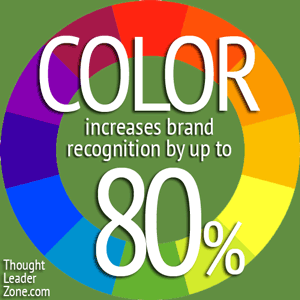Last summer a series of blogs on this site focused on a color theme and looked at pink matters and gray matters and even the varied colors of the Olympic rings. But is there a color connected to thought leadership?
Over the last few months, a new communications group I belong to has been considering that question as we put together our consultancy website. More about that in the future; but in the meantime, I invite you to review some of the interesting articles I’ve found on using color to market products…products like ”brand YOU.”
The first notable article from sajan.com discusses how color affects your global marketing campaigns and cites three reasons to use color when you promote a product, according to research by the Color Marketing Group:
- Color increases brand recognition by up to 80 percent.
- Ads in full color are read up to 42 percent more than similar ads in black and white.
- Color can be up to 85 percent of the reason people decide to buy.
If you’re interested in promoting your thought leadership globally, be aware of how the connotation of colors can differ from region to region, as illustrated by this well-researched infographic. Another infographic illustrates how colors, among other factors, have an impact on your decision to buy a particular product.
A second insightful article at webpronews.com looks at color as a powerful psychological trigger of emotions that attract or repel a buyer. The author points out the positive and negative reactions that specific colors evoke and suggests that you use either harmonious or complementary colors to give your marketing collateral a unified look. Also, by reviewing colorful ads created by professionals in trade magazines, for example, you can see what’s ”in” or ”out” in your industry.
Even eBay has advice for sellers who want to select colors to promote their products online. According to their research, blue is the best-selling color and the favorite color of most people in the world.
In addition, blue is the most common brand color in the corporate world, according to another article. This article, however, presents a contrary point of view to much of the other research, as indicated by its title “Customers Are Color Blind.”
What’s your opinion? Do you believe color plays a role in consumer choice? What color do you associate with thought leadership? Add your thoughts in the comments or click here to submit your vote and share your reasoning why.
Does your own color choice accurately reflect your brand? Do you need professional assistance as you develop your website or other marketing material to promote your thought leadership brand? Ask assess, then act. We’re here to help!

